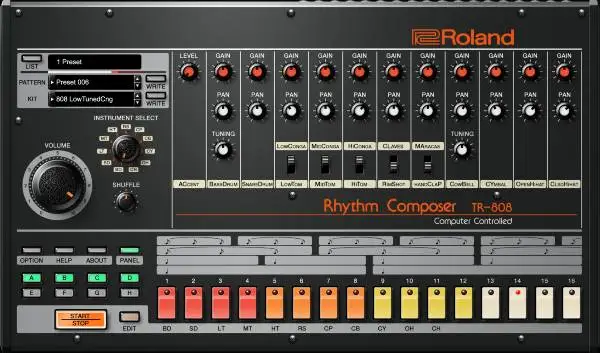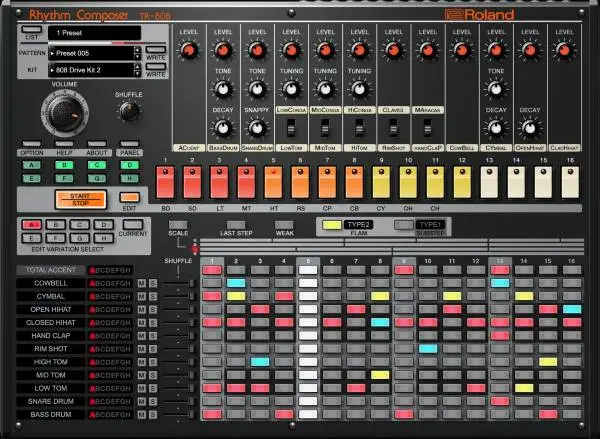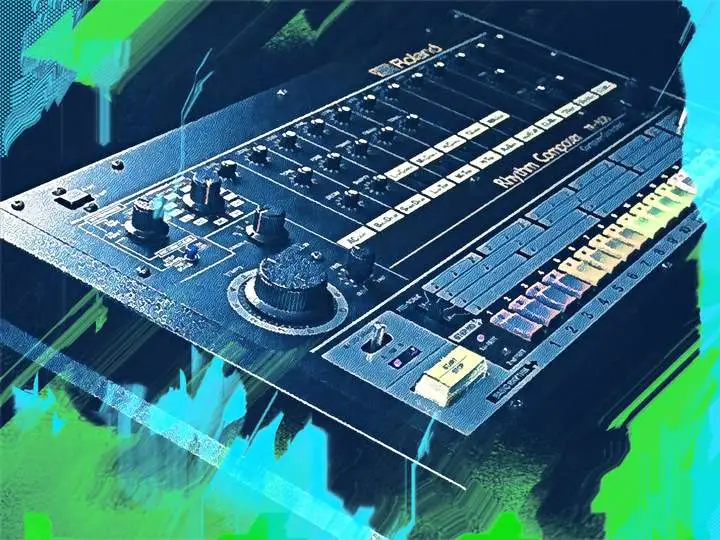Sir Mix-a-Lot famously said,
"The 808 makes the girlies get dumb."
For more than three decades now, the sound of the 808 has been the staple of hip-hop . To this day, it is one of the most popular sounds in modern music and probably as important as the Fender Stratocaster is to rock and roll.
So what about the 808 makes it such a sought-after sound, and how can you make some dope-sounding 808s for your tracks?
Come dive in with us as we explore all there is to know about the foundation of hip-hop: The 808.
What Is An 808?
Long before beatmakers started downloading samples from Splice and transferring gigabytes of drum sample packs from one hard drive to the next, there was the Roland TR-808 Drum Machine . This iconic drum machine, which used unique sound-generating hardware, bore several unique drum samples, including the famous 808.
The beauty of the original 808 came from its deep and subby characteristics, which producers could tune to various pitches depending on the track material.
However, the original Roland TR-808 had several sounds beyond the 808, including:
- Kick
- Snare
- High Tom
- Mid Tom
- Low Tom
- Cowbell
- Clap
- Closed Hat
- Open Hat
- High Conga
- Mid Conga
- Low Conga
- Rimshot
- Clave
- Maraca
- Cymbals
With static noise at its foundation, the 808 was uniquely designed to sound similar to a beater striking a resonant drum head. As a result, the original 808 had a fast, pointy attack and a short decay.
Of course, today's 808s have changed quite drastically.
Roam around Splice, and you'll hear thousands of 808 recreations, many of which have been compressed, distorted, and transient-manipulated.
History of 808s
“The Roland gear began to be a kind of Esperanto in music. The whole world began to be less separated through this technology.”
Graham Massey - 808 State
As we said before, the 808 came from the Roland TR-808 Drum Machine, which came out back in the early 80s. When it first hit the market, it was a commercial failure. Many people saw the TR-808 as a little robot toy that would never make it a "serious" instrument in the studio.
During this time, electronic music hadn't quite broken through. Plus, the Linn LM-1, which had a higher fidelity sound, garnered much more attention. But, of course, many underground producers couldn't stomach the $5,000 price tag for the Linn LM-1 and felt that the $1,200 price tag for the TR-808 was much more justifiable.
Compared to the LM-1, the TR-808 had 16 pre-loaded analog sounds and a more intuitive interface.
During the 80s and 90s, the 808 was mainly used by house and techno producers. However, pioneering hip-hop producers in the 90s also found something quite unique about the 808.
Producers like Afrika Bambaataa and Rick Rubin began using the 808 in early hip-hop, changing the auditory landscape. In fact, Bambaataa was one of the first major hip-hop acts to put the 808 on the map back in 1982 with the release of "Planet Rock."
In 1983, after selling next to 12,000 Roland TR-808 units, Roland discontinued the drum machine. However, in 1984, Roland replaced the unit with the TR-909, which was the very first drum machine to use MIDI.
When samplers and DAWs came about, standalone drum machines began dying out. However, we're now starting to see a resurgence of modern drum machines with new, high-end features that trump the vintage drum machines of the 80s and 90s.

How To Make 808s
Don't have thousands of dollars at your disposal to buy the original drum machine?
You're in luck, as there are millions of 808 samples online. The beauty of modern 808s is that they've been processed for added girth and power.
Let's take a look at how you can make an 808 that works for your production.
1) Find The Right Sample
First things first, you must start with a good sample.
There is no use in wasting your time trying to shape and tune a low-quality 808 sample. Depending on the DAW you're using, there might be some stock 808s to work with.
However, if you want more options, we recommend heading out to Splice and checking out the platform's massive database of 808 samples.
2) Sample & Tune
Because 808s are made with sub oscillators, you can tune them to specific pitches. Tuning your 808 is crucial . It's pretty tricky to get away with an 808 that isn't in the key of your track.
Finding the key of your track is an entirely different lesson that would require a new article, though there are hundreds of resources online to help you determine the key you're in.
Once you know what key your track is in, you can throw your 808 samples in a digital sampler and adjust the tuning up or down.
3) Fit Within the Context of Your Mix
An 808 that sounds great on its own is pretty cool, though if it feels weak or overpowering in the context of a mix, you may have some adjustments to make. Ideally, the fundamental frequency of your 808 should lie somewhere between 30Hz and 60Hz .
You might have a bassline and kick in your mix too, which also occupy that frequency range. If that's the case, you'll need to perform some puzzle-piece EQing to gel everything together.
More often than not, you'll have to EQ some of the low-end out of your bass and kicks for your 808s to fit nicely.
4) Shape Your 808 with ADSR
More often than not, you want your 808 to have a hard-hitting attack. People want 808s to rattle their trunks, not slide gently against their speakers like some kind of electronic cello.
To help your 808 hit, try increasing the attack time. If you have a kick alongside your 808, however, you might decrease the attack time so that the kick has a chance to pop through before your 808 comes in.
It's also a good idea to shape the decay, sustain, and release of your 808 so that it moves in time with your track.
5) Get Funky With The Sound Design
Just like you know you're listening to John Bonham when you hear his booming drums or Jimi Hendrix when you hear a fuzzy Strat riff, there are many producers out there who have shaped their 808s in such a way that they've found a way to stand out from other producers.
From distortion to compression and beyond, there are so many music production techniques you can use to alter the sound of your 808.
Features of 808
The 808 drum machine is packed with several features and sounds, including the bass drum, snares, toms, claves, a cowbell, hi-hats, cymbals, and the almighty handclap.
The "TR" in the TR-808 name stands for transistor rhythm.
This vintage drum machine uses transistors to create a step sequencer, allowing music producers to program up to 32 distinct patterns. With the CR-78 feature, producers can place accents on individual drum sounds.
With numerous audio outputs, DIN sync, and volume knobs, old producers could sync up their TR-808s with other synthesizers and musical equipment.

The Reception of This Iconic Drum Machine
While the TR-808 drum machine might seem legendary to modern hip-hop music producers, it didn't always have that reputation. For many years, it was ignored by the popular music industry and put off as a toy rather than a serious drum machine.
However, this booming bass drum machine became a staple for underground hip-hop and electronic music artists thanks to its affordability.
As more and more underground artists used the Roland TR-808 drum machine, famous artists began taking note. It wouldn't be long until artists like LL Cool J, Whitney Houston, Marvin Gaye, Public Enemy, and Run-DMC would use the TR-808 in their production.
An old-school UK electronic music group by the name of 808 State popularized the Roland TR-808 in early dance music production. It continued to grace music production throughout the new wave era and into the age of acid house and rave culture.
Famous Songs That Use 808s
Listen to many popular songs, and you'll hear lyrical references to the sound of the 808, including songs from Lil Wayne, Kanye West, Outkast, Kelis, and the Beastie Boys.
However, what really helped the 808 achieve mainstream success was its actual use in popular music. Here are some of the most iconic songs that make use of the 808 drum sound.
Sexual Healing - Marvin Gaye
Electronic percussion solidified itself in popular music thanks to Marvin Gaye, who made this ultra-popular hit after he cut ties with Motown back in 1982. Not only did "Sexual Healing" have one of the strongest vocal melodies in his career, but the way that unique coupled 808s with hyperactive guitar parts was something people in the pop music industry had never quite heard before. In many ways, people believe it was Marvin Gaye that started the TR-808 revolution.
I Wanna Dance With Somebody - Whitney Houston
The Roland TR-808 had taken over the industry by the late 80s, and you could hear it on more hits than any other drum machine on the market. One of the best examples of its use was on the opening bar of Whitney Houston's "I Wanna Dance With Somebody."
While critics initially tore the track apart, it eventually became Houston's most famous song.
Let The Beat Build - Lil Wayne
The Carter III is arguably one of Lil Wayne's best records, and the fact that he sprinkled the sounds of the TR-808 all over "Let The Beat Build" proved his obsession over the drum machine. If the TR-808 samples weren't enough to make the point, the line, "Heh, c'mon, just a snare and an 808" should give you a clue.
Love Lockdown - Kanye West
808s & Heartbreak was one of Kanye West's most significant hit records, spawning a new point in his music career. Like many tracks on this album, "Love Lockdown" used an iconic 808 beat that is almost instantly recognizable.
Drunk in Love - Beyonce
"Drunk In Love" was an instant classic from the moment people streamed it off her 2013 BEYONCE album. While there is plenty to love about the song, including Jay-Z's "eat the cake" lines and Be's "surfbort," the harsh, heavily-processed 808s push speakers to their limits.
The Difference Between 808 and Kick
While the original "808" term was used to describe the TR-808 machine as a whole, the term is now used to describe the sound of the bass, which is often used in conjunction with a kick drum. It might be confusing for those who grew up in the 80s, where the original TR-808 kick was actually a kick drum, not a bass.
While you can still use the term 808 to describe the hi-hats, snares, or toms on the original machine, you can almost always assume that someone is talking about the sound of the bass when they say 808.
Nowadays, the main difference between a kick drum and an 808 is that the kick drum provides the initial attack for the low-end, while the 808 provides the bass sound that emanates after the initial kick sound. An 808 has a very particular pitch that a music producer can use to create basslines.
808 VST Plugins
Trying to find one of these vintage drum machines can be a challenge, which is why so many producers turn to the digital world to get the sounds they're after. Here are our top three favorite VST plugins for those looking to harness the sound of the 808.
Future Audio Workshop SubLab
One of our absolute favorite 808 VST Plugins is Future Audio Workshop SubLab . The beauty of this VST is that it was made for a single purpose, which is creating 808s. No matter what kind of sub-tone you are looking to create, whether, for hip-hop, dance music, or experimental electronic, SubLab gives you the tools to do with ease.
We like to think of SubLab as a hybrid VST of sorts, using an X-Sub bass synth layer underneath an analog synth. The interface is intuitive, giving producers an oscillator waveform and spectrogram to get better feedback about their samples.
You can easily create MASSIVE sub sounds and 808s using multiple layers and add saturation and compression with the built-in modules to bring your 808s to life.
With 69 included presets, you have plenty of starting points. However, if you choose to make your samples from scratch, it's nice knowing that this is one of the most user-friendly VST plugins on the market.
Niche Audio Planet 808
One of the best ways to speed up your music production is by using 808 kits that have already been processed to fit the vibe of your tracks. Niche Audio Planet 808 comes with 15 vibe-driven 808 drum kits perfect for a wide range of genres. The beauty of these kits is that each has various pitches, allowing you to easily fit them into your production, regardless of the key.
If you use Maschine or Ableton Live, know that the plugin has been carefully sculpted for intuitive digital sampling.
Wave Alchemy Revolution
Many people say that Revolution from Wave Alchemy is one of the most sonically accurate virtual drum machines on the market o today. You'll find several classic drum machines sprinkled into Revolution's interface, including the 909, 78, 606, and OB-DX. However, in our eyes, the TR-808 sounds are where this plugin really stands out.
Wave Alchemy programmed this virtual drum machine with thousands of 808 sounds and samples so that each time you play a note, you get extremely subtle differences. These differences in sound are what make the sound of analog so unique.
Plus, the sounds were recorded into a NEVE 1073 preamp and balanced Radial JDI, allowing the design team to capture the fullest frequency response possible. One of our favorite things about the Wave Alchemy Revolution is that you can mix and match iconic sounds to craft Frankenstein kits. If you're looking to get creative, Revolution can help you do it!
808 FAQs
Is 808 a Bass or Kick?
In modern music terminology, when people say 808, they are typically referring to the 808 bass sound. However, the original sound found on the TR-808 was a kick drum, much different than what we hear in modern production.
Who Invented the 808 Beat?
Ikutaro Kahehashi invented the 808 beat along with the Roland Corporation back in 1980, though the way that people utilized the TR-808 drum machine drastically changed over time.
What Are The Effects of 808?
When mixed and tuned properly, the effects of the 808 bass can be extremely powerful. With tons of low-end and hard-hitting attack, a great 808 bass sound can shake club walls and rattle trunk speakers.
What 808 Do Producers Use?
Producers use many different 808 samples in today's music, though most of these samples don't come from the original drum machines. If you're looking to find great 808 samples, we recommend heading to Splice and trying to find sample packs from your favorite producers.
How Loud Should Your 808 Be?
It's often best to keep your 808 at the same level as your kick drum or slightly quieter. Producers often think they need to make their 808s much louder, which can often result in muddy mixes and overwhelming low-end.
Do You Have To Sidechain Kick and 808?
A good rule of thumb is if your kick drum has a very sharp transient, you probably don't need a sharp transient on your 808 bass. One of the best ways to help your kick cut through is by sidechaining it to the 808 so that you 808 drops in level for a split second every time the kick hits.
Should Your 808 Be Mono?
Generally speaking, low-frequency 808 sounds should be in mono. However, if you want to spread your 808 bass, you can make a copy of it, high-pass it, and add delay, reverb, or chorus effects to spread it out while still maintaining the mono low-end.
Should You EQ Your 808 Bass?
It's always important to consider the relationship of your 808 bass to the rest of the tracks in your mix. We often recommend using subtractive EQ, such as a hi-pass filter, if you feel like your 808 is taking up too much room in your mix. If your 808 is having trouble poking through the mix, you can use additive EQ in the 400-800Hz range to give it a bit of grit.
Do Producers Use 808 Samples?
When it comes to modern music production, the sound of the 808 is a staple. From hip-hop to electronic music, it is one of the most iconic sounds around.
Can You Pan 808?
It is often better to keep your 808 sounds in mono, as panning them can result in a skewed stereo image. The same thing goes for your kick drums, bass, and snares. Having a foundation at the center of your track can help it hit much harder.





